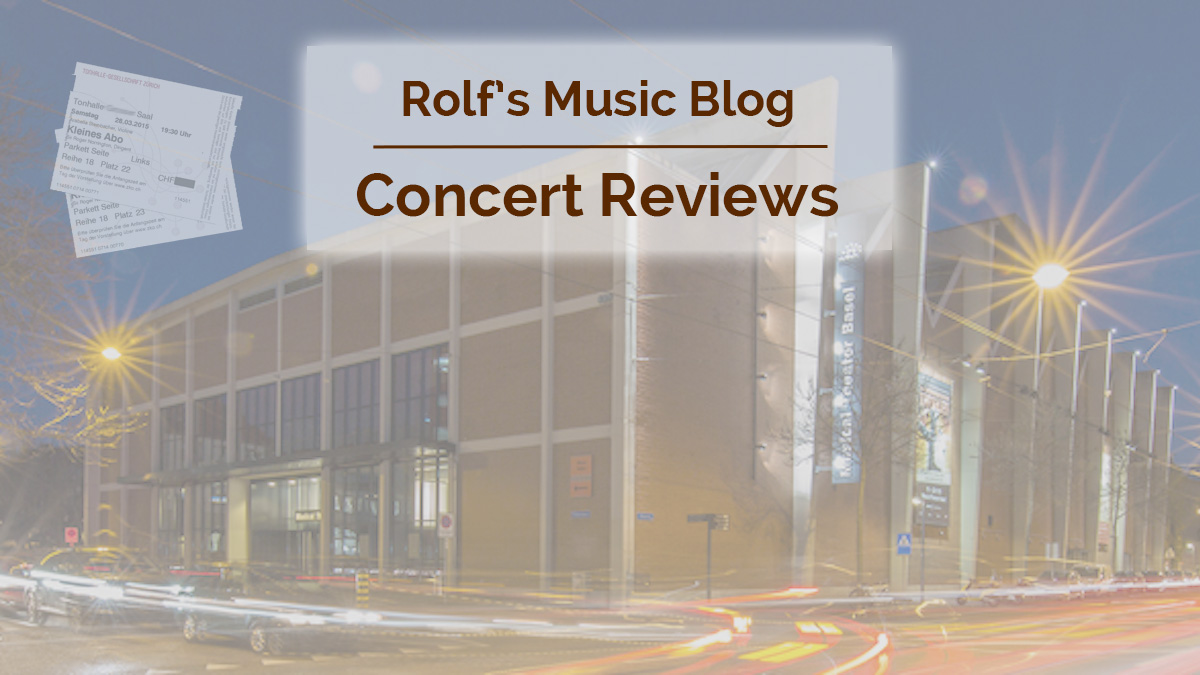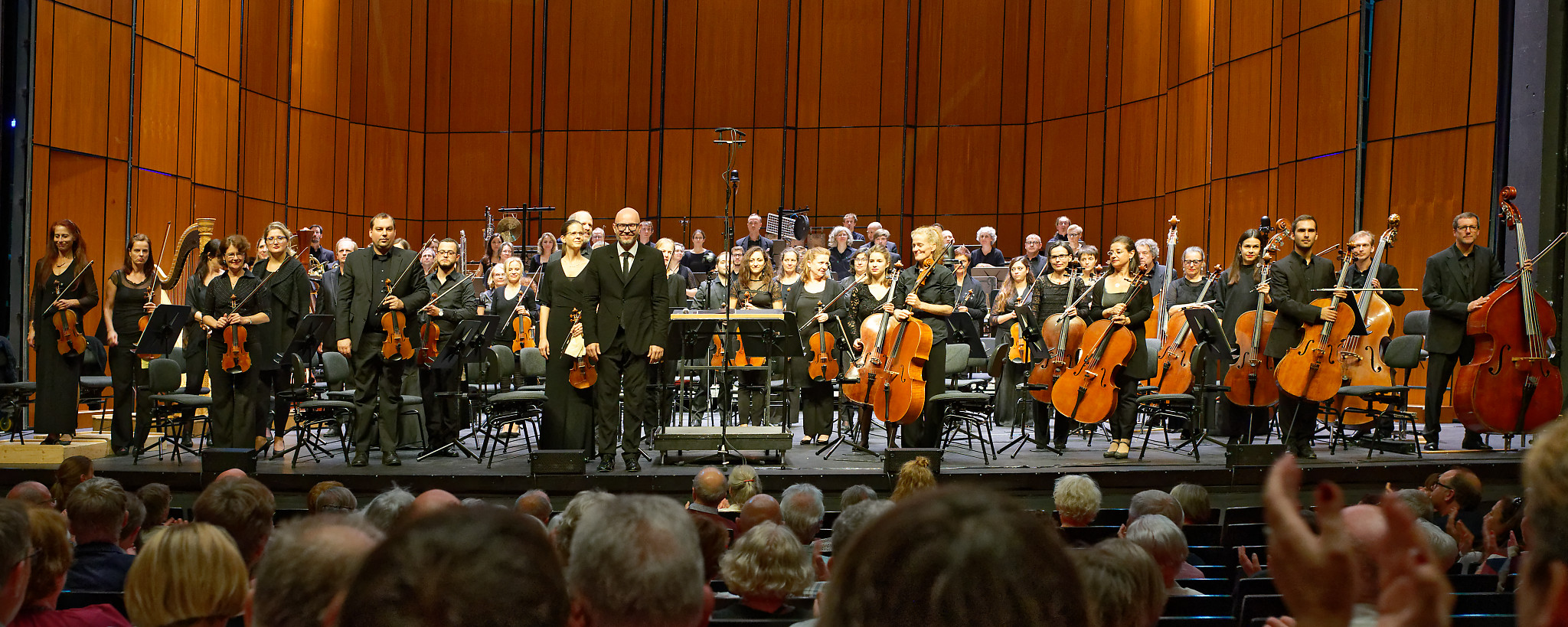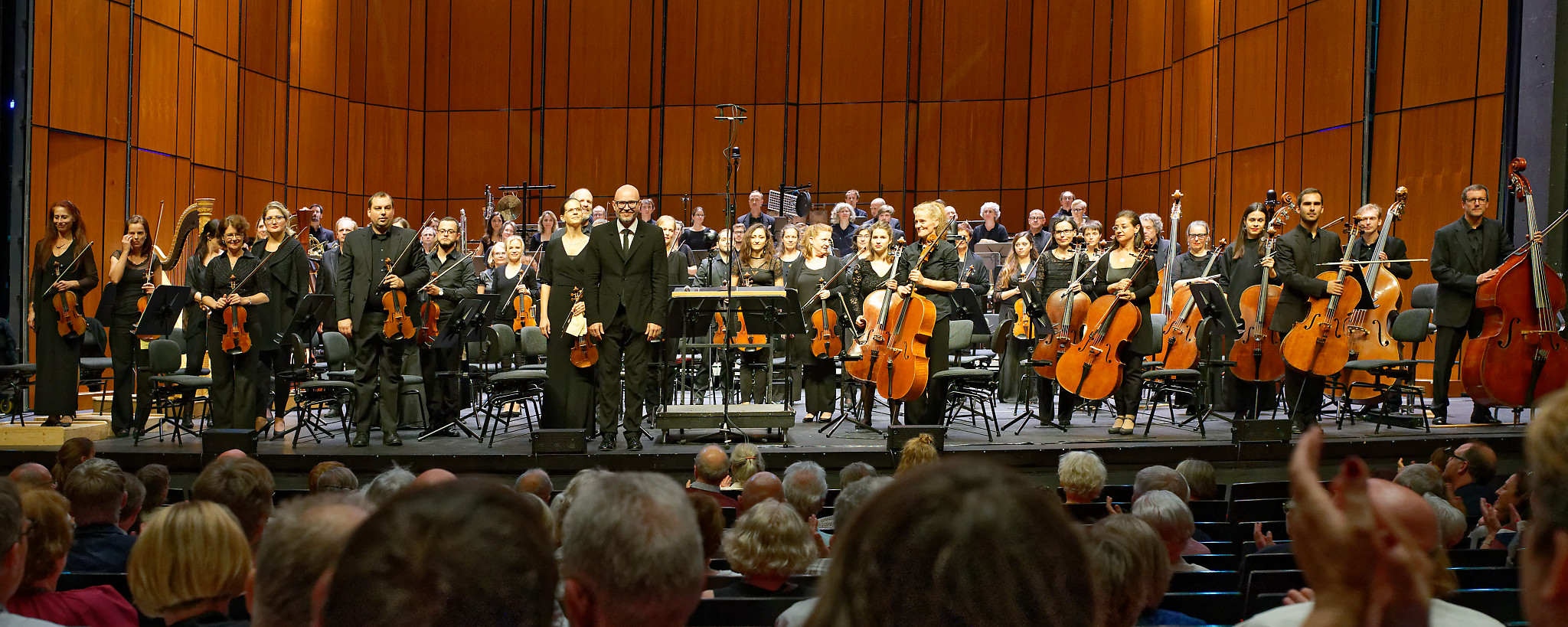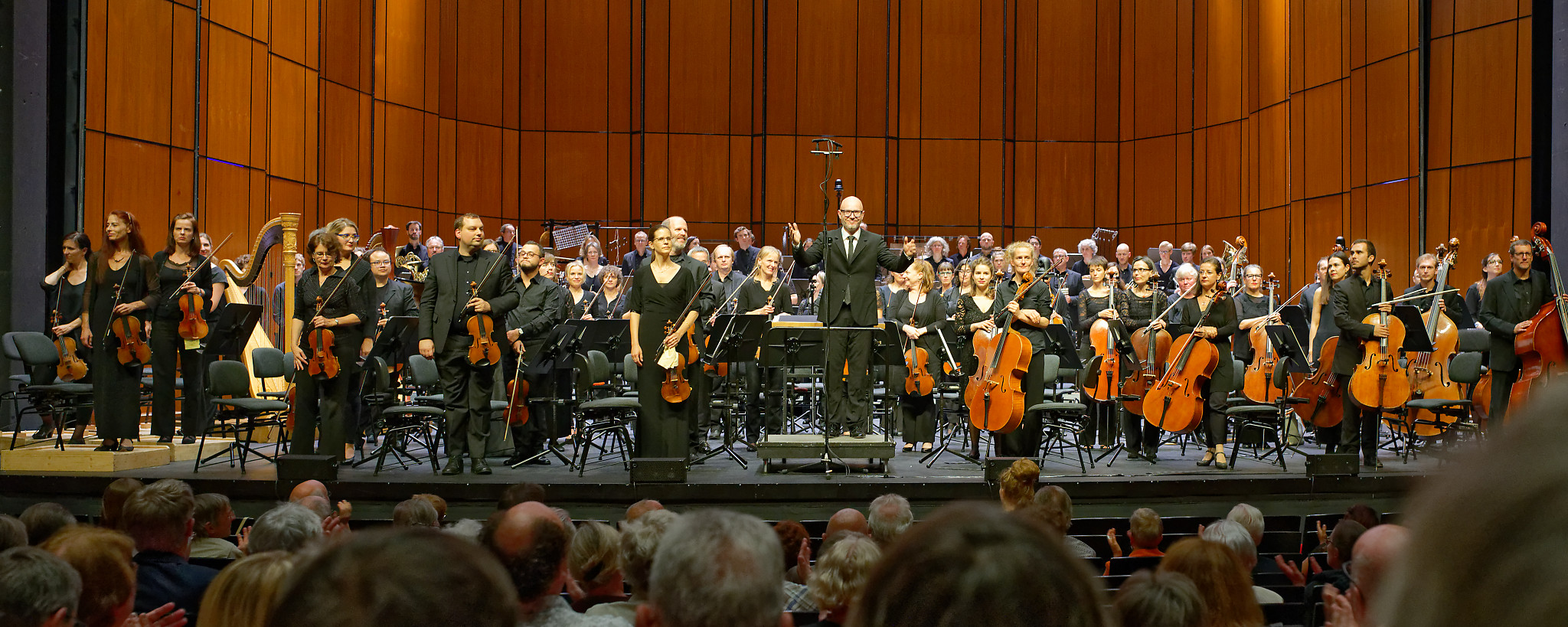Baldur Brönnimann / Basel Sinfonietta, OnStage Mobile App
Crumb / Furrer / Birtwistle
Musical Theater, Basel, 2018-09-16

2018-10-04 — Original posting
2018-10-05 — Added information about the makers of the OnStage mobile app
2022-02-07 — Amended for George Crumb’s death (2022-02-06)
2022-04-19 — Amended for Harrison Birtwistle’s death (2022-04-18)
Table of Contents
Introduction
This first of the subscription concerts of the Basel Sinfonietta (see also Wikipedia) for this season was part of the Festival KlangBasel. That’s a music festival in Basel, featuring some 100 concert over the course of 3 days, all supposedly in walking distance from each other. The Festival covered a wide range of music, from historically informed baroque music to contemporary (as this one, obviously).
The Basel Sinfonietta was playing under the direction of its chief conductor, Baldur Brönnimann (*1968, see also Wikipedia). I don’t need to introduce conductor and orchestra, as I have witnessed this conductor at the head of the Basel Sinfonietta in several earlier concerts. One of these concerts, on 2017-01-29, was in the same location, the Musical Theater Basel.
The “Festival KlangBasel” was an opportunity for the Basel Sinfonietta, for an appearance on a day when music lovers would be underway between the many events of the festival anyway. On the other hand, the various activities at the festival were also competing with each other: the venue in this concert was anything but sold out. My wife and I had seats close to the center of row 13.
The Program
This concert featured three compositions. All three works were less than 35 years old, one was even a “Swiss First” performance:
- George Crumb (1929 – 2022): A Haunted Landscape (1985)
- Beat Furrer (*1954): Nero su nero (2018, Swiss Premiere)
(Intermission) - Harrison Birtwistle (1934 – 2022): Earth Dances (1986)
Prior to the actual concert, there was also the opportunity to attend a concert introduction with principal Conductor Baldur Brönnimann. There wasn’t just a “Swiss First” performance in the center of the program, but actually also a world premiere of a software / app that expands the concert experience, see below.
Needless to say that I didn’t know any of these works beforehand, nor did I have the opportunity to study the scores prior to the concert. Therefore, I cannot discuss questions of Authenticity vs. Originality, my review below is merely descriptive. My rating stands for the (personal) concert experience. In this case, it also includes the impression that the music (rather than mostly the performance, as usual) made on me as a listener.
Before diving into the actual performance, let me first introduce a novel, key ingredient to the concert:
Smartphones in Use in Concert—A World Premiere!
No, for once, smartphones did not play the role of the usual, notorious and inevitable nuisance factor. rather, they were—for the first time ever—actually welcome for listeners to bring along and leave switched on! And no, the performance did not actively use these devices (e.g., to create sound, or a soundscape). Rather, besides the audio component and the direct visual experience, the smartphones opened up new channels, through which audience members could experience the performance:
OnStage — A Concert App for Smartphones
In order to expand and innovate the concert experience, the Basel Sinfonietta cooperated with App developers in Poland—and this concert was the first one in which that app (“OnStage”) received public exposure, turned into an active component / ingredient.
OnStage was developed under the hood of the Julian Cochran Foundation, an organization in Poland that works on a variety of “projects linking classical music with technologies”. The aim is, to change the perception of classical music, and to encourage new audiences to become music enthusiasts. Besides the OnStage app, active projects of the foundation include
- The International Cochran Piano Competition (the first international online piano competition, 2019 will be the fourth edition, after 2015, 2016, and 2017)
- Practice Rooms for Pianists
- Mała Klasyka / Classical Music for Kids
- Classic on Baskets / Classics at Hala Koszyki
- Business Partnerships
- Career Boost Academy
Installation of the OnStage App
OnStage is an app that was specifically designed to enrich the concert experience. Some of the features are
- One obviously needs to have the app downloaded / installed
- The phone remains on “mute”: even here we don’t want / need distractions from phones ringing etc. (and I’m so glad that odd Nokia tune is history, at last!)
- In the concert hall, the user connects to the local WiFi (network “OnStage”, also announced by the organizer).
- The app can be started any time. In this concert at least, “use without login” opened all available options
Static / Non-Interactive Functions
Features for use in connection with a concert can be divided into static and dynamic content. The static functions include
- A map to find the venue (this can call out to Apple Maps, Google Maps, or Uber, for interactive navigation)
- Information about the artists,
- about the composers, as well as
- about the venue
These static functions can also be called offline / outside of the concert.
“Live” Functions
The next set of functions are under “Live” and are only available during the concert:
- the detailed concert program
- there is a chat function (didn’t explore that here)
- the live video stream option permits tapping into live video, as recorded from several (ca. 5) cameras on the podium, within the Basel Sinfonietta, including the orchestra’s (front) view onto the conductor. One can freely switch between the cameras.
“Backstage” Functions
A third set of functions under “Backstage” includes
- access to orchestral scores (as PDF), which can be viewed during the performance. This is not a live function insofar, as the user must turn (swipe) pages by hand (not like one of these YouTube videos with “move-along score”).
- sending a message to the conductor / musicians
- sending a message to the organizer (the office of Basel Sinfonietta in this case).
Among these functions, the scores option is only active while connected to the concert WiFi.
What OnStage is not
At least in this concert, the “Live” and “Scores” functions were available during the concert exclusively. Users outside of the “OnStage” WiFi network didn’t and don’t have access. The video streams were only live, not recorded (no viewing after the concert).
OnStage is not a generic viewing / streaming platform. It is designed to work specifically in and with concerts where the associated WiFi network and broadcasting hardware has been set up. Also the off-line functionality (at this point) is only available in connection with concerts that are being or have already been attended.
Reality Check with the First Version
Although the software has a “full release” version number (currently 1.0.14, as of this writing), I regarded this as a kind of beta test / first real-world exposure. It was also a stress test for the infrastructure. Important: With the following comment I want to give a realistic report about my first encounter with the software, as it existed at the time of the concert, i.e., 2018-09-16.
By no means do I want to discredit the software or suggest that it is useless, etc.—quite to the contrary: for quite some time, I have been attending concerts with my iPad on my lap, in order to read scores during performances, and I find this a fascinating expansion, a development into the right direction for the (very) near future! And this makes use of today’s technology, rather than regarding it (i.e., smartphones) as a nuisance factor!
- I was told that the networking & computing infrastructures were laid out for 500 participants. There may have been around 400 – 500 people in the audience, and at one point during the concert introduction, the organizers claimed that 50% of the visitors had the app activated on their smartphone. Still, the live streams suffered from occasional stuttering. There was even a short instance when the network or the compute server crashed.
- The cameras were all static. Obviously, live camera control (zooming, panning, moves, etc.) would make the experience more interesting. Some of the streams / camera views were fairly boring, lacking action.
- There was (at least sometimes) a slight time shift. This was somewhat irritating while watching the conductor or the percussionist. With most other instruments, such a time shift is less obvious, hence less irritating.
I should not forget to mention that during the entire concert I did not notice a single phone ringing!
Desirable Expansions
- It would be desirable to have either a full-screen mode, and/or a dark mode theme (text / portions outside the video stream in white-on-black, rather than black-on-white). This way, the numerous smartphone screens in the audience would be visually less distracting (and yes, there were moments where listeners were looking up from their own screen, into the orchestra!). Plus, with a full-screen mode or a dark theme, there would not be bright parts in the display that decrease the contrast in the video image.
- The app also runs on the iPad (and presumably Android tablet devices)—though only in iPhone mode / resolution. At some point, a full iPad version would be desirable. Sure, right now, the bigger resolution would seriously increase the network & computing load, so this may only be for the mid-term future.
- I did find the iPad useful for following the orchestral score, though. However, for scores with the complexity of those in this concert, even that was of limited use, unless one was zooming in—but then it was easy to lose track. The conductor’s desk / score stand must have been close to one square meter!
How to get OnStage
The OnStage App is a free app for smartphones. It can be downloaded from the standard sources (AppStore for iPhones / iOS, Google Play for Android-based devices). It’s best to search for “onstage altkom” (“onstage” alone matches many apps, hence may yield too many results).
Crumb: A Haunted Landscape (1984)
The American composer George Crumb (1929 – 2022, see also Wikipedia) is the author of a broad range of works: orchestral works, instrumental chamber music, piano and vocal music.
His composition “A Haunted Landscape” (1984) expresses the fact that certain locations seem to create déjà vu experiences. Locations, geological formation, etc. that seem to reflect, to evoke a mysterious memory of events that happened in these locations in the past. The evoked sensations include threat, awe, or memories of idyllic situations / constellations. A constant, mostly very soft tone (the empty C string, tuned down to B♭) on the double bass indicates a kind of “cosmic roaring in the underground”. The composition uses a rich setting of 45 percussion instruments (from Cambodia, Japan Brazil, the Caribbean, the U.S., up to an amplified piano, and harps).
The Performance & the Music
As indicated, I cannot give an analytic description of the works in this concert. Let me just report what we (my wife and I) heard, as per the notes that I scribbled down during the performance. So, here it goes:
After an introductory ffz “bang” (repeated after a few seconds), the B♭, ppp sempre, sets in, with two double basses—and it remains there throughout the piece, up to and including the very last bar. Apart from the two bangs, this seems to be the sole element initially (accompanied only by coughing in the audience). A large variety of interjections (motifs, fragments), initially very soft and deep, then louder, up to fff on the drums, later winds, brass. Intermittently whispering, harmonious chords, like distant memories hovering, hushing by. The scenery, though, appears like a rough landscape (or rock formations), depicted through very loud melody fragments, grumbling in the underground.
Incisive sounds—and then again an idyllic nature scenery, children calling, the harmony of the spheres even? I guess one could see transcendental aspects in this music, if not abstract, religious aspects? More memories, allusions to music, but in fragments so short that they are hardly assignable: imaginative music, full of pictures. Sharp, grinding dissonances—and yet, somehow, it seems tonal, be it only though the presence of that constant B♭.
Baldur Brönnimann conducted the Basel Sinfonietta with a firm hand, offering unerring guidance throughout the piece, giving the (seemingly) constant base beat, keeping the large team in line, while leaving freedom in short solos. It’s really fascinating music, full of tension, even suspense, from beginning to end.
Rating: ★★★★½
Amendment, 2022-02-06
George Crumb passed away on 2022-02-06, aged 93.
Furrer: Nero su nero (2018, Swiss Premiere)
Beat Furrer (*1954) is one of the most important Swiss contemporary composers. 1985, he founded the Klangforum Wien, one of Europe’s leading orchestras for contemporary music. He is still conducting that ensemble. His output as a composer ranges from orchestral, ensemble, chamber, solo and vocal music up to opera.
The composition “Nero su nero” (Black on Black) is from 2018. It premiered in Vienna, in June, but was modified since, hence this performance is a combination of a Swiss Premiere and second World Premiere. For a description, let me just translate excerpts from the text in the program notes:
The title (…) talks about levels of darkness, of nuances of light, the application of color without color, the layering, intensifying of pigments. The “colors” are in the spreading of many layers of voices (…). there are two major segments from heterogeneous elements surrounding a slow middle part. That latter part is a big, relentless development towards a bright, loud, frenetic glee / glowing, starting from, minute, almost unnoticeable alterations: an incessant intensification leading up to an immensely dramatic climax. (…) from the dark to the bright.
The two layers (black on black) are often presented as winds against (or over) the strings.
The Performance
This piece brought a sharp contrast to Crumb’s. Where the “Haunted Landscape” is silent, subtle, this one is shrill, loud; where Crumb’s composition uses a monotonous base beat, this one is rhythmically intricate, complex. As for that latter aspect: Baldur Brönnimann conducted this from the huge score (filling his conductor table!) with the usual firmness and clarity, the Basel Sinfonietta is familiar with such music, formed a firm team, a unity with the conductor. This held true throughout the evening.
The Music
While in the score, the structure with the two layers seems clear, the dominating impression of the first part is “loud”. Already the first bar goes from mf/f up to ff, in ascending scales in the winds, followed by fast tremolo (occasionally reminding of a swarm of bees) and slow, microtonal glissandi in the strings, contrariwise creeping / crawling. One can best describe this as “screaming darkness”, the sounds from the winds altered between “busy, heavy, often very dissonant industrial noise” and occasional screaming of animals in a slaughterhouse.
Then, suddenly, the central part, an oasis of calm, slowly, gradually altering sound planes, expectation, suspense airy sounds in the winds, gradually intensifying, volatile sounds of the strings showing up at the horizon. And then, the volume builds up again, gradually, initially unnoticeably building up, very slow glissandi in the strings, faster scales in the winds, more and more incisive again, resolute string signals, “infinitely descending and ascending glissando”, “primordial breathing underneath”, always growing—very, almost unbearably loud—and a sudden, abrupt ending (not with a bang, just a loud dissonance).
My wife found this too oppressing (intimidating even, maybe?). I personally found the composition interesting, for sure. However, I must concede: it was very loud, indeed (to the point where I started worrying about musicians in the Basel Sinfonietta damaging their ears!), and I understand why listeners might find such music oppressive.
Rating: ★★★½
Birtwistle: Earth Dances (1986)
Harrison Birtwistle (1934 – 2022) as one of the most important contemporary composers doesn’t need an introduction. His work “Earth Dances” dates from 1986. It is dedicated to Pierre Boulez (1925 – 2016). This is a big composition, a “dense cross-work with ups and downs of boiling sound matter, forming new constellations.” The program notes compare the sound layers in this composition to geological layers that are shifting against, over and under each other, or “a semi-extinct volcano on top of eruptive forces waiting for their liberation.”
The Music
The piece starts with a loud thunder, then grunting, “earthly sounds” between resting notes: a foundation layer of broad structures. Opposing textures, like geological layers shifting against each other. Violins and violas fighting large-scale geological processes / events? A slow, rhythmic structures seems to depict a ritual dance. I did not hear a lot of tonal relationships, except for temporary, local “centering” around resting notes, and momentary tonal segments. Growing complexity and diversity in the textures (rhythmic and in harmonies). One can probably identify specific “geological layers” (musical, recurring pattern), but that would be a challenge for first-time listeners.
In my personal experience, over time, the sound impression changed with the time, away from an interplay of tonal and dissonant aspects, towards a dominance of a rich set of sound colors—and multi-faceted rhythmic features, from irregular, almost aleatoric to occasional, strongly rhythmic / motoric segments. Definitely, the music is never even remotely boring. However, I would claim that an average listener would need to listen to this piece several times, in order to find / “see” (understand?) a significant portion of the cross-relations / structural elements in this music.
The Performance
Also here, the Basel Sinfonietta convinced with its focus, the concentration and discipline, guided by Baldur Brönnimann’s firm conducting hand, and supported by very active and attentive first desks. Professionals in all aspects, certainly for this kind of music.
Rating: ★★★★









